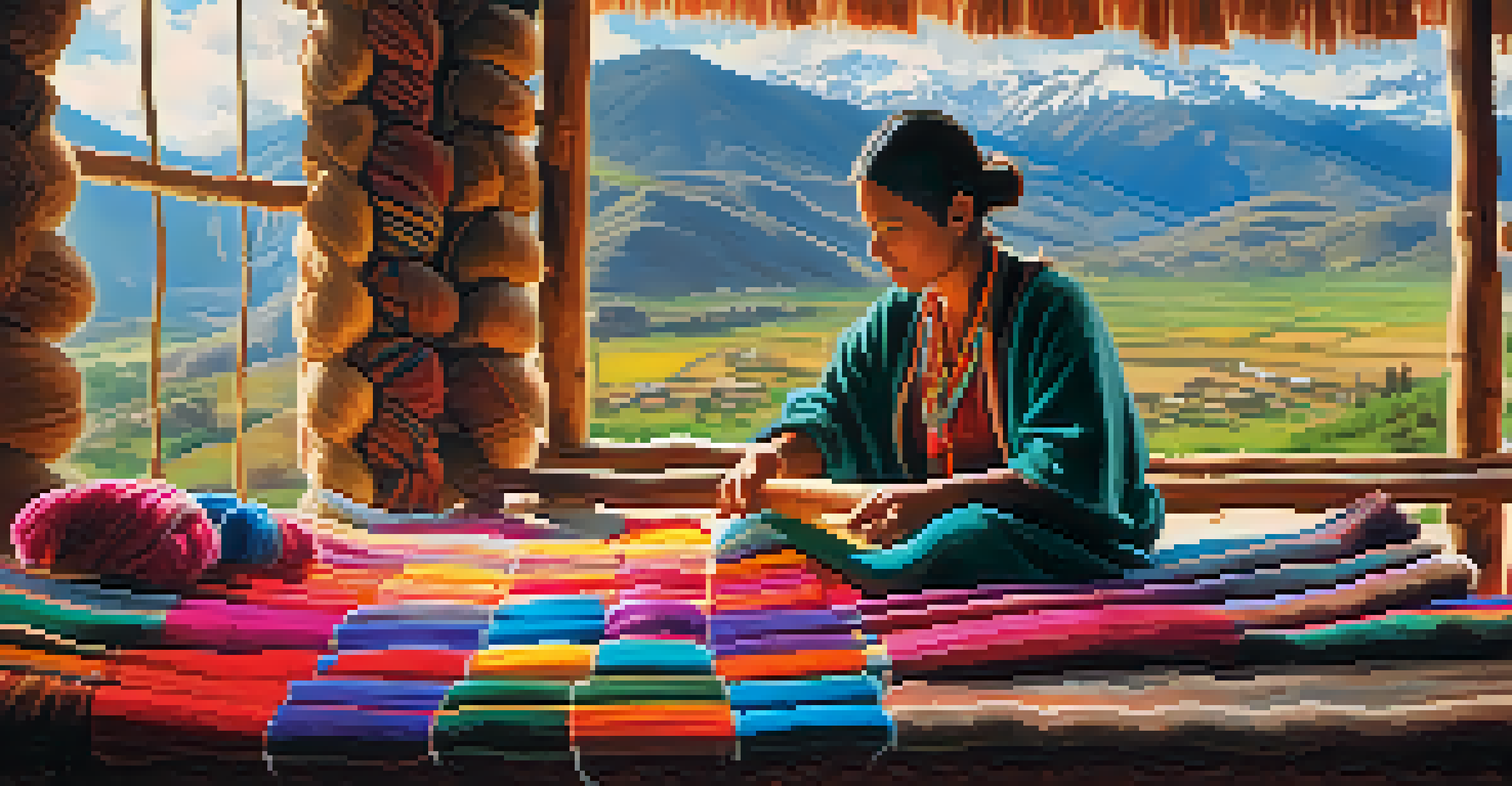Sustainable Hiking Trails in the Sacred Valley of Peru

Understanding the Importance of Sustainable Hiking
Sustainable hiking is more than just a trend; it's a necessary practice for preserving our natural environments. When we hike sustainably, we minimize our impact on the landscapes we love, ensuring they remain pristine for future generations. This approach not only protects flora and fauna but also enhances the hiking experience by fostering a deeper connection with nature.
The greatest threat to our planet is the belief that someone else will save it.
In places like the Sacred Valley of Peru, where the ecosystem is incredibly rich, sustainable practices play a crucial role. By following designated trails, hikers help prevent soil erosion and protect delicate habitats. Moreover, sustainable hiking promotes awareness and respect for local cultures and traditions, enriching the overall journey.
Ultimately, embracing sustainable hiking means being mindful of our footprint. It encourages us to leave no trace, to take only memories and photographs, and to support the local communities that rely on eco-tourism for their livelihoods. This thoughtful approach transforms our hiking adventures into opportunities for conservation.
Top Sustainable Hiking Trails in the Sacred Valley
The Sacred Valley is home to a variety of hiking trails that cater to all skill levels, each offering unique experiences. One standout trail is the Inca Trail, renowned for its breathtaking views and historical significance. As a designated UNESCO World Heritage site, it's vital to hike this trail responsibly, ensuring that its beauty and history are preserved.

Another fantastic option is the Ollantaytambo to Lares trek, which not only showcases stunning landscapes but also allows hikers to interact with local communities. This trail promotes sustainable tourism by encouraging visitors to stay in locally-owned accommodations and support local artisans. It's a wonderful way to experience the culture while minimizing environmental impact.
Embrace Sustainable Hiking Practices
Sustainable hiking minimizes environmental impact and fosters a deeper connection with nature.
For those looking for a less-traveled path, the Patacancha Valley offers serene hiking routes through vibrant fields and traditional villages. This area is often overlooked, making it a perfect spot for travelers seeking tranquility and authenticity. By choosing these lesser-known trails, hikers can help distribute the benefits of tourism more equitably across the region.
Best Practices for Sustainable Hiking
To hike sustainably, it's essential to follow a few best practices that protect the environment. First and foremost, always stick to marked trails. This not only helps preserve the surrounding flora but also minimizes your risk of getting lost. Creating new paths can lead to soil erosion and harm local wildlife.
In every walk with nature, one receives far more than he seeks.
Next, consider your waste. Bring reusable containers for snacks and water, and always pack out what you pack in. This simple practice reduces litter and keeps the trails clean for everyone. Remember, even biodegradable items can take time to decompose in certain environments, so be mindful of what you leave behind.
Finally, respect wildlife and local communities. Observe animals from a distance and never feed them, as this can disrupt their natural behaviors. Additionally, learning about local customs and engaging with communities can enhance your experience while promoting respectful tourism. Sustainable hiking is not just about the environment; it's about people and cultures too.
The Role of Eco-Tourism in the Sacred Valley
Eco-tourism has become a vital aspect of the Sacred Valley's economy, offering travelers an opportunity to connect with nature while supporting local communities. By choosing eco-friendly tour operators and accommodations, hikers can contribute to the preservation of the environment and promote sustainable practices. This form of tourism not only benefits the ecosystem but also empowers local residents.
Many local initiatives focus on conservation and environmental education, providing visitors with insights into the region's biodiversity and cultural heritage. For instance, some organizations offer programs that allow hikers to participate in reforestation projects or community clean-up efforts. This hands-on approach creates a lasting impact and fosters a sense of responsibility among travelers.
Explore Eco-Friendly Trails
The Sacred Valley offers diverse hiking trails that support local communities and promote responsible tourism.
In essence, eco-tourism transforms the act of hiking into a meaningful experience. It encourages travelers to be more conscious of their choices and understand the importance of sustainable practices in preserving the Sacred Valley's beauty for generations to come.
What to Pack for a Sustainable Hiking Trip
Packing wisely is essential for sustainable hiking, as it helps reduce waste and ensures you have everything you need for an enjoyable adventure. Start with a durable, reusable water bottle to minimize single-use plastic. Many trails in the Sacred Valley have refill stations, so you can stay hydrated without harming the environment.
Consider bringing eco-friendly snacks in reusable containers. This not only keeps your food fresh but also reduces packaging waste. Opt for items like dried fruits, nuts, or granola bars that provide energy during your hike while being easy on the planet.
Lastly, don’t forget to pack a small trash bag. Even if you plan to leave no trace, having a designated bag for any waste you encounter on the trail is a responsible choice. By cleaning up after yourself and others, you help maintain the beauty of the Sacred Valley for everyone to enjoy.
Understanding Local Flora and Fauna
The Sacred Valley is a biodiversity hotspot, home to unique plants and animals that contribute to its ecological richness. As hikers traverse the trails, they have the opportunity to learn about this fascinating ecosystem. For instance, the region is known for its diverse array of orchids, some of which are endemic to the area. Understanding and appreciating these plants can enhance the hiking experience.
Birdwatchers will also find plenty to admire, as the Sacred Valley is home to various bird species, including the Andean condor. Observing these magnificent creatures in their natural habitat reinforces the importance of conservation efforts. It reminds hikers that protecting these species is integral to maintaining the region's ecological balance.
Pack for a Green Adventure
Choosing eco-friendly gear and snacks is essential for reducing waste and enhancing your hiking experience.
By educating ourselves about local flora and fauna, we deepen our connection to the environment and foster a sense of stewardship. This knowledge encourages hikers to respect the ecosystems they encounter, promoting sustainable practices that benefit both nature and local communities.
The Future of Sustainable Hiking in the Sacred Valley
As awareness of environmental issues grows, so does the need for sustainable hiking practices in the Sacred Valley. The region's popularity as a tourist destination brings both opportunities and challenges. While eco-tourism can provide economic benefits, it also demands careful management to prevent over-tourism from damaging the delicate ecosystem.
Local authorities and organizations are increasingly implementing measures to promote sustainable practices. Initiatives like limiting the number of hikers on popular trails and creating education programs for visitors can help mitigate the negative impacts of tourism. By fostering a culture of sustainability, the Sacred Valley can continue to thrive as a destination for responsible travelers.

Looking ahead, the future of sustainable hiking in the Sacred Valley relies on the collective efforts of tourists, local communities, and stakeholders. By prioritizing conservation and responsible tourism, we can ensure that this breathtaking region remains a cherished haven for generations to come.